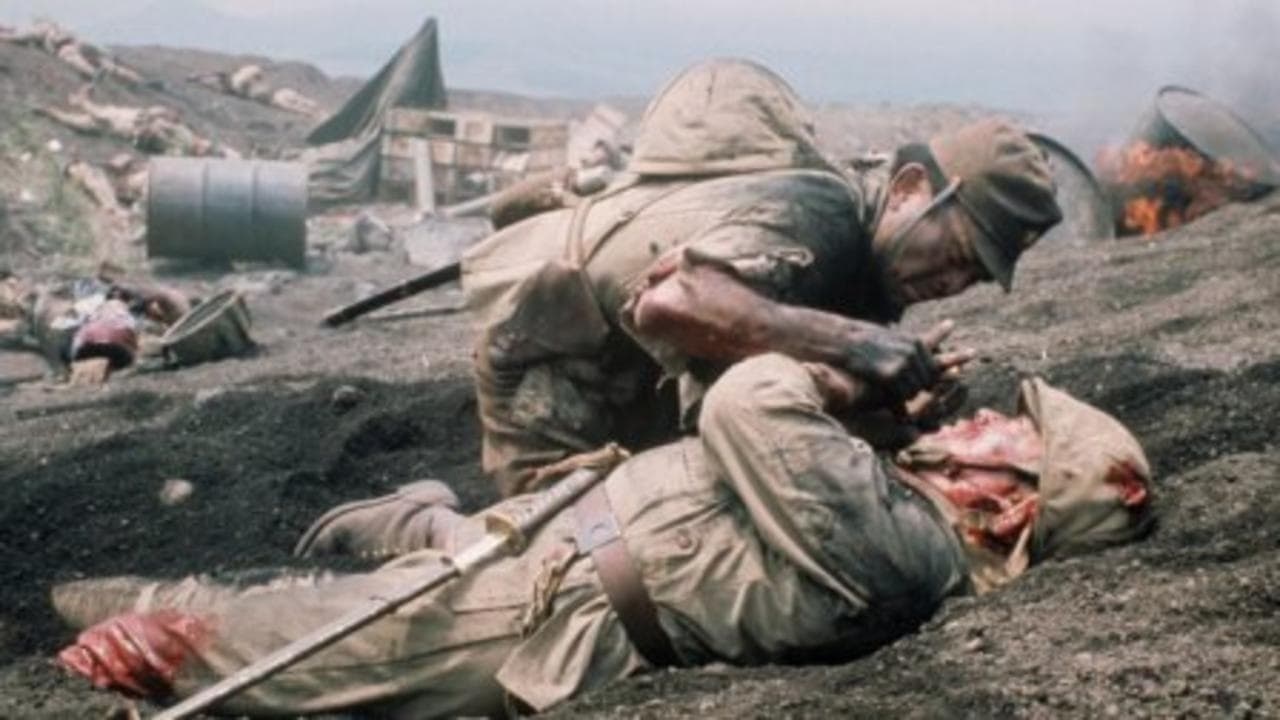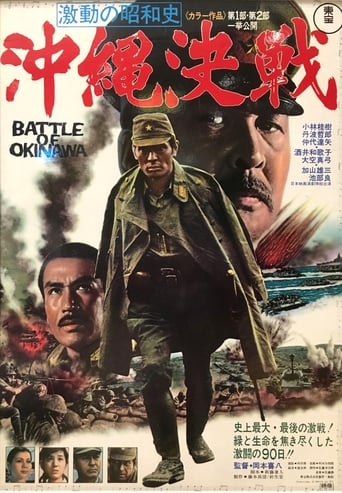

I was at first put off by the goofy humor in this...it was almost slapstick humor and badly misplaced in this sort of film. The history is way off in its accuracy... for example: it accused the US of using gas bombs and they were not used...that was against the Geneva Convention. We did use flame throwers and blow up cave entrances to seal in the people who refused to surrender. Being a veteran I thought the explosions supposedly from the US ships off the coast were much, much too small. Even small howitzers caused much more damage than the shells landing in this film did. I lived there as a small boy and learned from the Okinawan people that they were fed a line of drivel as to what we would do to them, so they were very fearful of the US troops but they quickly learned that the Japanese had lied to them. Okinawan natives did not consider themselves Japanese at the time. "Flags of Our Fathers" and "Letters From Iwo Jima" are much better films and even though it is a different battle see those for much more of the truth.
... View MoreI have a desire to look deeply into films from 1971 and came upon this oddity which is on R1 DVD, but still pretty much unknown. It is directed by Kihachi Okamoto who was a versatile director, happy directing comedy alongside such far as Dai-bosatsu tôge / Sword of Doom (1966), perhaps the greatest chambara movie going. As well as that The Battle of Okinawa stars Tetsurô Tanba and Tatsuya Nakadai, the two most famous Japanese actors of a generation disregarding Mifune. No slouch at directing himself (Onibaba, Kuroneko) Kaneto Shindô was involved in writing the script. So there's pedigree aplenty for the movie.The Battle of Okinawa ended very shortly before the atomic bombings ended the entire conflict in the Pacific. It was a battle of cataclysmic ferocity that accounted for the lives of a quarter of a million people, which included a third of the island's civilian population. It was almost the end of a civilisation and a way of life, Okinawans having a distinctive culture that was almost obliterated here. The Americans never left, almost a fifth of the island is still occupied by US military bases.The movie is both educational on the tactical side of the battle, but also revelatory about Japanese culture of the time. The military triumvirate on the Japanese side consisted of General Ushijima, and his two subordinates Lieutenant General Isamu Cho (Tanba) and Colonel Hiromichi Yahara (Nakadai). Ushijima is an almost catatonic buddha who admits having inferior tactical knowledge and so chooses sides in arguments between Cho and Yahara. Cho tends to favour aggression, Yahara is always more moderate. Nakadai here wears the same expression on his face all the way through the movie, maybe he grimaced and the wind changed, for he wore it all the way through Hideo Gosha's great movie The Wolves, also released in 1971. Joking aside though it's an iconic expression, which is awesomely fatalistic, seeming in one go to express the sheer lunacy of the pro-imperial attitudes in the army, and the desire to die. Yahara's appears to be the greatest lunacy though, he opts to let the American forces land unopposed in order to conserve ammunition, which would be needed for later in the battle.There are many terrible things that happened during the battle, so many families committed suicide in order to avoid contact with the American troops. It's still a point of controversy as to how willing they were, and how much they were forced to by the army. Families gathered round in circles and unpinned grenades, the survivors attempted to batter each other out of their misery. Quite spectacular suicide missions are commemorated. For example a plane landing in a US-controlled airfield (the rest of the squadron succumbing to anti-aircraft fire), troops disembarking and throwing grenades at the US planes, entirely without hope of surviving It's quite interesting to discuss whether the movie glorified the resistance, certainly suicide missions are shown as heroic, whilst entirely unpalatable to the Western eye, but also the movie does question whether there is more to life, a greater reason to live than merely to serve the Emperor.Some disappointments from a cinematic point of view, firstly the archive footage that announces the film is shot in 4:3 but here massively stretched to 2.35:1, which looks pretty sloppy. Then the film is not very well budgeted I feel so the action often looks kind of fake, but also there wasn't enough cash in the kitty to get Americans over, so the American soldiers (who generally hide their faces, are seen from behind or in the distance) are played by Japanese as well. Luckily we don't see Americans very often, their presence is only known via artillery bombardment, and when we do it's not Thompson sub-machine-guns that they're carrying. Actual combat scenes are very stylised and reminiscent of jidai-geki such as Ran in the way that the platoons of soldiers behave. It's fortunate that the Americans don't play a part in the movie, to the defenders on Okinawa they may as well have been Martians, the issues here were all Japanese, about what attitude to take in the face of cultural destruction and overwhelming incursion. That's not to downplay the loss of American life, but that would simply be for another movie.I felt in the end that the film was a fitting testament to the deaths of the defenders of Okinawa and the populace. The movie kind of captures an essence of bravery, lunacy and hollow childlike subservience, as well as the sheer devastating horror.
... View MoreHow do you go about depicting one of the largest and most violent battles of the Pacific Theater of WWII? Is it possible to capture the ugliness and gruesomeness of a battle with 150,000 civilian casualties on celluloid and most important can any depiction by one or the other side be really impartial? The Battle of Okinawa (BOO from now on) succeeds beyond all expectations on the first and better than it has any right to in the second - it doesn't resort to cheap flag-waving but it's not without a sense of patriotism either.The first hour of the film is devoted to the strategic planning of the battle - Kihachi Okamoto however is smart enough to spice up what in lesser hands could have been boring exposition and setup with a breakneck pace that makes this first hour just whiz by. As is obvious from the title, the protagonist in BOO is the battle - and its victims. It's not a character-driven piece as all the main characters are painted in broad strokes but it's a sprawling war drama that takes us in a bloody tour through every pore, nook and cranny of Okinawa - from the shellshocked trenches and battlegrounds to the primitive hospital set up in a cave lacking all necessities and in itself an image of Dante-ish hell on earth, people screaming and passing out and others having their legs amputated with dull hacksaws and nurses trying to ventilate the place so the injured won't suffocate, to women and children and other civilians hudled together in a cave and gas bombed by American troops to the Army headquarters where officers argue for tactics. Nothing is spared by Okamoto's lens - this is literally the battle of Okinawa in all its morbid glory.The credentials of the creative team should be the final guarantee that BOO is a movie well worth seeing. Directed by Kihachi Okamoto (SWORD OF DOOM, KIRU, RED LION) and written by Kaneto Shindo (ONIBABA, KURONEKO) and with Tatsuya Nakadai and Tetsuro Tamba spearheading the cast, you really can't go wrong here. It's as bleak and nihilistic as Okamoto's previous chambara output would suggest and not an easy watch for the squeamish - but therein lies the true power of the movie. Even when it resorts to images we might consider trite by now (a little child walking through dozens of corpses in the aftermath of the battle) it's still done with conviction that is true to story and setting.If we have become jaded by all the images of war and suffering the news networks have only been too eager to churn out and exploit for our curious eyes, war and suffering has lost none of its potency. BOO is not an impartial depiction of the battle - how could it be? It's not a documentary anyway. The patriotism and self-sacrifice of Japanese troops (a form of seppuku in itself) must have made eyes in Tokyo, Hiroshima and Kyoto glisten with tears. Is it not understandable though? Okamoto is not carried away with sentimentality though - this is a slice of war brutality and comes with arms chopped and parents killing their children so they won't fall in enemy hands.
... View MoreBattle of Okinawa is a film directed by the now legendary Kihachi Okamoto. It stars Tatsuya Nakadai and Tetsuro "I'm in every Japanese film" Tamba. Both show off their acting chops in this film and deliver outstanding performances. Don't get me wrong though, there are dozens of actors in this film with almost equal scream time as these two men. This is definitely an ensemble piece on one of the most gruesome slaughters on the Japanese armies front. This film is not easy to watch. It is much more violent than "Letters From Iwo Jima" and as in "Iwo" we see how fanatical the Japanese army was at this point in history. Being taken prisoner was not an option and losing meant death or forever living in dishonor. This notion is even implemented to civilians who in this move kill themselves in droves. Tatsuya Nakadai's character is one of the few characters who believes that suicide in not the only option in defeat. He is the western voice in the film for his character even studied in America. This is a hard core war film that takes no prisoners. I recommend you go out and buy this film for it is now available in R1 DVD thanks to the fine folks at AnimEigo.
... View More